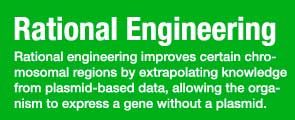| | Chassis engineering or strain engineering focuses on the modification of chromosomes instead of plasmids and encompasses both <a href="https://2012.igem.org/Team:UC_Davis/Project/Our_Strain">directed evolution</a> | | Chassis engineering or strain engineering focuses on the modification of chromosomes instead of plasmids and encompasses both <a href="https://2012.igem.org/Team:UC_Davis/Project/Our_Strain">directed evolution</a> |
| - | and <a href="https://2012.igem.org/Team:UC_Davis/Project/Our_Strain">rational engineering</a>. This part of the project focuses on the degradation of ethylene glycol, a chemical that is metabolized to oxalic acid further downstream. Oxalic acid is toxic to the kidney and fatal to the organism. (For a look at how we handled these compounds safely, look at our <a href="https://2012.igem.org/Team:UC_Davis/Safety">Safety Page</a>!) | + | and <a href="https://2012.igem.org/Team:UC_Davis/Project/Our_Strain">rational engineering</a>. This part of the project focuses on the degradation of ethylene glycol, a degradation product of PET that is metabolized to oxalic acid further downstream the metabolic pathway. Oxalic acid is toxic to the kidney and fatal to the organism. (For a look at how we handled these compounds safely, look at our <a href="https://2012.igem.org/Team:UC_Davis/Safety">Safety Page</a>!) |
| - | We found an <I>E. coli</I> mutant, called Strain E-15 EG3, in scientific literature from the University of Barcelona, that is able to grow solely on ethylene glycol, one of the two products created during PET degradation [1]. The scientists in Barcelona created these mutants through directed evolution, a process that selects for the most fit in a group. Then, the scientists performed ethyl methylsulfonate (EMS) on the cultures, plated the cells on media with ethylene glycol, and restreaked the colonies several times. From this, they learned that the main contributors in the degradation were propanediol oxidoreductase and glycolaldehyde dehydrogenase. These two enzymes are expressed at low levels in MG1655 but not at all in DH5α. We want to overexpress these enzymes in MG1655 through directed strain engineering. Rather than take the enzymes from Strain E-15 EG3, we want to clone the enzymes from the MG1655 and be able to control them ourselves, also known as rational strain engineering.
| + | Once we discovered the potential toxicity of our project, we searched high and low to find ways to eliminate ethylene glycol (EG) as much as possible. In the scientific literature, we found an <I>E. coli</I> mutant, called Strain E-15 EG3, from the University of Barcelona, that is able to grow on ethylene glycol alone [1]. E-15 EG3, which is originally derived from MG1655, was created through directed evolution, a process that selects for the most fit in a population. Then, the scientists performed ethyl methylsulfonate (EMS) on the cultures, plated the cells on media with ethylene glycol, and restreaked the colonies several times. From this, they learned that the main contributors in the degradation were propanediol oxidoreductase and glycolaldehyde dehydrogenase. These two enzymes are expressed at low levels in MG1655 but not at all in DH5α. We want to overexpress these enzymes in MG1655 through directed strain engineering. Rather than take the enzymes from Strain E-15 EG3, we want to clone the enzymes from the MG1655 and be able to control them ourselves, also known as rational strain engineering. |
| - | Ethylene glycol is a potential toxin to any mammals that consume it, so we are taking extra measures to ensure the proper disposal of it. We want to break down the ethylene glycol product from the cutinase-driven degradation of polyethylene terephthalate (PET) so that none of the ethylene glycol is released into the environment. We have engineered our <I>E. coli</I> to degrade the ethylene glycol after breaking down PET so that no human intervention is necessary. | + | Ethylene glycol (EG) is a potential toxin to any mammals that consume it, so we want to break down the ethylene glycol product from the cutinase-driven degradation of polyethylene terephthalate (PET) so that none of the ethylene glycol is released into the environment. We have engineered our <I>E. coli</I> to degrade the ethylene glycol after breaking down PET so that no human intervention is necessary. |
| | <br>Our main goal is for the <I>E. coli</I> to be able to live off PET as the sole carbon source. In order to do this, it must be able to sequester the carbon into its metabolism. In the diagram below, the ethylene glycol binds to the glycolaldehyde reductase to form glycolaldehyde. After, the glycolaldehyde attaches to the glycolaldehyde dehydrogenase to form glycolate. The glycolate goes in to the metabolism via further reactions with glycolate dehydrogenase and malate synthase. The (S)-malate is the final product that is incorporated in to the citric acid (TCA) cycle. As the citric acid cycle propagates, more energy is made for the cell, allowing growth and self-sufficient development on PET. | | <br>Our main goal is for the <I>E. coli</I> to be able to live off PET as the sole carbon source. In order to do this, it must be able to sequester the carbon into its metabolism. In the diagram below, the ethylene glycol binds to the glycolaldehyde reductase to form glycolaldehyde. After, the glycolaldehyde attaches to the glycolaldehyde dehydrogenase to form glycolate. The glycolate goes in to the metabolism via further reactions with glycolate dehydrogenase and malate synthase. The (S)-malate is the final product that is incorporated in to the citric acid (TCA) cycle. As the citric acid cycle propagates, more energy is made for the cell, allowing growth and self-sufficient development on PET. |

 "
"






















